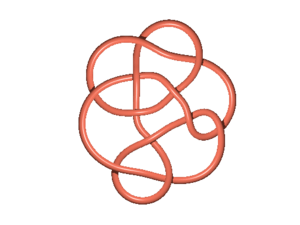Lisa Piccirillo facts for kids
Quick facts for kids
Lisa Piccirillo
|
|
|---|---|
| Born | 1990/1991 (age 33–34) |
| Education | |
| Known for | Solving the Conway knot problem |
| Awards |
|
| Scientific career | |
| Fields | |
| Thesis | Knot traces and the slice genus (2019) |
| Doctoral advisor | John Luecke |
Lisa Marie Piccirillo (born 1990 or 1991) is an American mathematician who is the Sid W. Richardson Regents Chair in Mathematics at the University of Texas at Austin. She works in the fields of geometry and low-dimensional topology. In 2020, Piccirillo published a mathematical proof in the journal Annals of Mathematics determining that the Conway knot is not a smoothly slice knot, answering an unsolved problem in knot theory first proposed over fifty years prior by English mathematician John Horton Conway.
From 2020 to 2024, she was an assistant professor of mathematics at the Massachusetts Institute of Technology.
Contents
Early life
Piccirillo was raised in Greenwood, Maine, and attended Telstar Regional High School in Bethel, Maine. Her mother was a middle school math teacher.
As a child, she had many hobbies, such as riding dressage, being involved in her church's youth group, and participating in drama and band in school.
Education
Piccirillo earned a B.S. in mathematics from Boston College in 2013 and a PhD in low-dimensional topology at the University of Texas at Austin under the supervision of John Luecke in 2019, followed by postdoctoral research at Brandeis University.
Boston College professor Elisenda Grigsby cited Piccirillo's creativity as contributing to her success, adding that Piccirillo did not fit the mold of a "standard golden child math prodigy" during her undergraduate studies.
Work
The Conway knot was named after its discoverer, English mathematician John Horton Conway, who first wrote about the knot in 1970. The Conway knot was determined to be topologically slice in the 1980s; however, whether or not it was smoothly slice (that is whether or not it was a slice of a higher dimensional knot) eluded mathematicians for half a century, making it a long-standing unsolved problem in knot theory.
This changed with Lisa Piccirillo's work on the Conway knot, which completed the classification of slice knots with under thirteen crossings, as the Conway knot had been the last outstanding knot in its group fully unclassified. Her proof made use of Rasmussen's s-invariant, and showed that the knot is not a smoothly slice knot.
Piccirillo first learned of the Conway knot problem in 2018 at a conference on low-dimensional topology and geometry. She was a graduate student at the time and spent less than a week working on the knot in her free time to "see what's so hard about this problem" before finding an answer:
I think the next day, which was a Sunday, I just started trying to run the approach for fun and I worked on it a bit in the evenings just to try to see what's supposed to be hard about this problem.
Before the week was out, Piccirillo had an answer. A few days later, she met with Cameron Gordon, a professor at UT Austin (a senior topologist), and casually mentioned her solution. She stated later:
It was quite surprising to me. I mean, it's just one knot. In general, when mathematicians prove things, we like to prove really broad, general statements: All objects like this have some property. And I proved like, one knot has a thing. I don't care about knots. So, I do care about three and four dimensional spaces, though. And it turns out that, when you want to study three and four dimensional spaces, you find yourself studying knots anyway.
The Washington Post reported that her proof had been "hailed as a thing of mathematical beauty, and her work could point to new ways to understand knots."
Following the publication of Piccirillo's proof in Annals of Mathematics, she was offered a tenure-track position at the Massachusetts Institute of Technology set to begin fourteen months after the completion of her doctorate.
Recognition
In association with the 2021 Breakthrough Prizes, Lisa Piccirillo was awarded one of three 2021 Maryam Mirzakhani New Frontiers Prizes, for early-career achievements by a woman mathematician. The other two winners were Nina Holden and Urmila Mahadev.
She was also awarded a 2021 Clay Research Fellowship for "her work in low-dimensional topology" and a 2021 Sloan Research Fellowship.
Additionally, Lisa was counted as one of "The world's top 50 thinkers for the Covid-19 age" by UK magazine Prospect in 2020.
See also
 In Spanish: Lisa Piccirillo para niños
In Spanish: Lisa Piccirillo para niños


